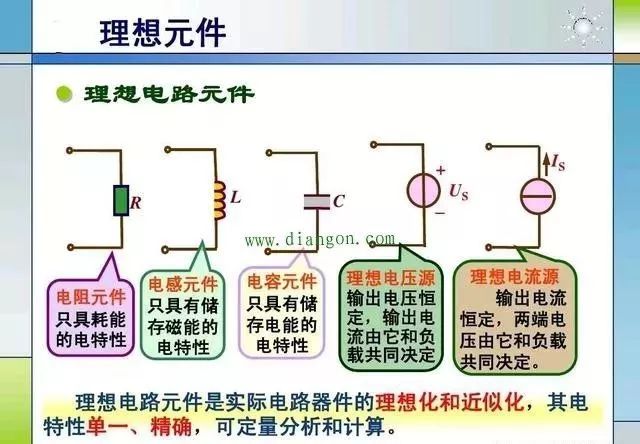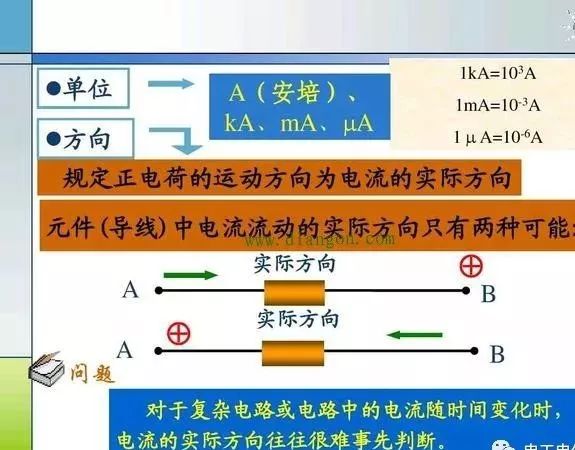The electrician's master knows that the theoretical knowledge of electricians is very important. Theoretical knowledge can guide practical experience to a certain extent. It is the foundation of electrician development. Of course, it is also very important to have electricians mastering some of the electrician terminology. Otherwise, it will inevitably be awkward to communicate with professionals!
1. Current: A free flow of electrons or ions in a conductor under the influence of an electric field force. A regular flow is called current. It is stipulated that the positive charge moves in the positive direction of the current. The current is represented by the letter I and the unit is A.
2. Current intensity: The physical quantity that measures the strength of a current. The amount of electricity that passes through the cross-sectional area of ​​the conductor per unit time is the current intensity, denoted by the letter I, and is customarily referred to as current.
3. Current density: The size of the current passing through a unit cross-sectional area, called the current density. The unit is A/mm2.
4. Potential: In the electric field, when the unit positive charge moves from point a to the reference point, the work done by the electric field force is called the potential of point a to the reference point. For theoretical research, infinity points are often used as reference points for potentials; in practical engineering, the earth is often used as a reference point for potentials. The unit of potential is V.
5.Electromotive force: The work done by a non-electrostatic force on a unit of positive charge from a low electric displacement to a high electric potential is called an electromotive force. Expressed with the letter E in units of V
6. Resistance: Conductors can conduct electricity and have resistance to current. This ability to hinder the passage of current is called resistance and is expressed by the letter R or r in units of Ω.

7, resistivity: also known as the resistivity factor. Is a measure of the physical properties of a good or bad object, with the letter Ï, the unit is Ω · m. The value is the resistance value of a uniform conductor having a length of 1m and a cross-sectional area of ​​1mm2 at a temperature of 20C, that is, the resistivity of the conductor.
8, the temperature coefficient of the resistance: the physical quantity that the resistivity of the material changes with temperature, its value is equal to the ratio of the resistivity change and the original resistivity when the temperature rises by 1°C, expressed by the letter d, the unit is 1/°C.
9, Conductivity: The ability of an object to conduct current is called conductance. The reciprocal of the resistance value is the conductivity, denoted by the letter G, and the unit is S (Siemens).
10, conductivity: also known as conductance coefficient. It is a physical quantity that measures the electrical conductivity of a material. Its magnitude is the reciprocal of the resistivity. Expressed by the letter γ, the unit is S/m (West/meter).
11, self-inductance: When the current in the closed loop changes, the flux generated by this changing current and passing through the loop itself will change. In this loop, the induced electromotive force will be generated. This phenomenon is called Self-inductance phenomenon. This induced electromotive force is called self-induced electromotive force. The coefficient of proportionality between the flux that passes through the area enclosed by the loop and the current that produces this flux is called the self-inductance coefficient of the loop, referred to simply as the self-inductance. Its value is equal to the electromotive force caused by the self-inductance when the current changes by one unit per unit time. It is expressed by the letter L and the unit is H (Henry).
12, mutual inductance: two adjacent coils, when the current in any one coil changes, then in the other coil induced electromotive force, this electromagnetic induction phenomenon called mutual inductance. The resulting induced motor potential is called mutual electromotive force. Expressed with the letter M, the unit is H. Inductance: The collective name for self-inductance and mutual inductance.

13, Capacitance: Any two conductors separated by an insulating medium constitute a capacitor. The amount of charge stored on each plate under the action of a unit voltage is called the capacitance of the capacitor, denoted by the letter C, and the unit is F (farad).
14. Inductive reactance: When the alternating current flows through the circuit with inductance, the inductor has the effect of hindering the alternating current. This effect is called inductive reactance, expressed by XL, and the unit is Ω.
15. capacitive reactance: When the alternating current flows through a circuit with a capacitor, the capacitor has the effect of hindering the alternating current. This function is called capacitive reactance and is represented by XC and the unit is Ω.
16, Impedance: When AC current flows through a circuit with resistors, inductors, and capacitors, the effect of blocking the passage of AC current is called impedance.
17, DC: The current that does not change in size and direction with time is called DC, AC: The current whose size and direction changes periodically with time is called AC.
18, sinusoidal alternating current: alternating current that changes with time according to sine law is called sinusoidal alternating current. Non-sinusoidal alternating current: AC current that does not change in accordance with sine law over time is called non-sinusoidal alternating current.
19, pulsating direct current: The current whose magnitude changes with time and whose direction is constant is called pulsed direct current.
20, Frequency: The number of times the direction of the current in the alternating current is changed within 1 s is called the frequency. It is expressed by the letter f and the unit is Hz (Hertz).
21, Period: The time required for every alternating current of the alternating current is called the period, which is represented by the letter T and the unit is s (seconds).
22. Instantaneous value: The value of alternating current at any instant is called the instantaneous value, which is represented by lowercase letters. For example, i, u and e respectively represent the instantaneous values ​​of current, voltage and electromotive force.
23, Maximum: The maximum amplitude value in the instantaneous value is called the maximum value, which is expressed in uppercase letters with a subscript m, such as Im, Um, and Em respectively representing the maximum values ​​of current, voltage, and electromotive force.
24, rms: If the heat generated by a certain alternating current through a certain resistance for a certain time is equal to the heat generated by a certain dc through the same resistance at the same time, the value of the direct current is called the effective value of the alternating current, ie the alternating current The effective value is the DC value that is equivalent to its thermal effect. The uppercase letters I, U, and E represent the effective values ​​of current, voltage, and electromotive force, respectively.
25, Average: The average value of AC refers to the ratio of the total charge flowing through the circuit over a period of time to the period of time. The average value of sinusoidal alternating current usually refers to the average value in the positive half cycle.
26, Electrical work: The work done by the current is called electrical work, and the symbol W is expressed in units of J (Joules) and kW · h (kW/h).
27, Electric power: The work performed by the current per unit time (1s) is called the electric power and is represented by the symbol P, and the unit is W or kW.
28, Instantaneous power: The power at any instant in the AC circuit is called instantaneous power and is represented by the sign Pt in units of W or kW.
29, Active power: The average value of the instantaneous power of a sinusoidal AC circuit over a period, called active power, is represented by the letter Pa in units of W or kW.
30. Apparent power: The product of the effective value of the current I and the voltage U is called the apparent power and is represented by the letter S or Ps in units of V · A or kV · A.
31. Reactive power: In a circuit with an inductance or capacitance, the energy of the power source becomes stored in the magnetic field (or electric field) during a period of half a cycle, and stored in a magnetic field during the other half of the cycle. (or electric field) energy is released and returned to the power supply. It only exchanges energy with the power source and does not consume energy. The amplitude of the rate at which energy is exchanged with the power source is called reactive power and is represented by the letter Q or Pr in units of var or kvar.
32, power factor: The ratio of active power to apparent power is called power factor cos φ.
33, Efficiency: Energy always consumes part of the conversion or transmission process, that is, the output is less than the input. The ratio of the output energy to the input energy is called efficiency. It is represented by the letter η.
34, phase voltage: In the three-phase circuit, the voltage between the phase line and the neutral line is called the phase voltage. Line voltage: In a three-phase circuit, the voltage between the phase line and the phase line is called the line voltage.
35, phase current: three-phase circuit, the current flowing through each phase is called the phase current. Line current: In a three-phase circuit, the current in the three end lines is called the line current.
36, loss of electric field: the charge (or charged) into other spaces around the charged body will be subject to force, that is, there is an electric field around the charged body.
37. Electric field strength: The physical quantity that indicates the strength of the electric field. It is numerically equal to the force that a unit of positive charge is subjected to at that point, and the direction is the direction in which the positive charge is subjected to force. Expressed by the letter E, the unit is V/m.
38, Breakdown: The phenomenon of severe discharge or conduction under the action of an electric field is called breakdown, and the dielectric strength is also called breakdown field strength.
39, Dielectric constant: A factor that represents the insulating properties of a material, expressed by the letter ε, in units of F/m. Relative dielectric constant: The ratio of the dielectric constant ε to the vacuum dielectric constant ε0 of any substance is called the relative dielectric constant and is represented by the symbol εr.
10inch Tablet,Kid Tablet,Android Tablet,WiFi Tablet
C&Q Technology (Guangzhou) Co.,Ltd. , https://www.gzcqteq.com